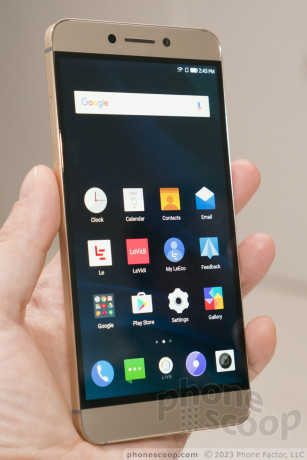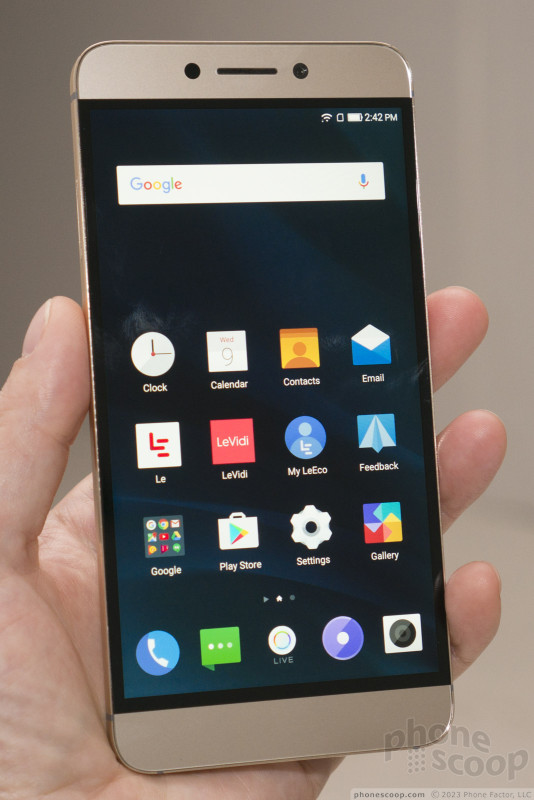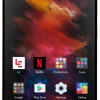Hands-On with the LeEco S3
Nov 9, 2016, 3:53 PM by Eric M. Zeman

LeEco's S3 smartphone is one of two handsets the Chinese company hopes will entice US buyers to take a chance on the brand. The S3 combines a metal chassis and mid-range specs with lots of video software to make for an affordable content-consumption machine. Here are our first impressions.
LeEco is hoping to break into the US market with a pair of new smartphones, the S3 and Pro3. The two phones share nearly identical designs and footprints, though there are a few important differences between them. Both offer metal unibody construction with decent specs and lots of ways to watch video.
If the S3 looks somewhat familiar to you, you're not going crazy. LeEco appears to have drawn at least some inspiration from HTC, OnePlus, and other Android phone makers in crafting the S3. I'd call the design almost generic, as far as metal-and-glass handsets go. It has a high-end look, but not quite a high-end feel.
The S3 is the less expensive of the two handsets from LeEco and you can tell when you handle them together. The phone has an attractive metal frame that is polished to a shine along the edges for an attractive chamfer. Metal forms the majority of the rear panel. Plastic caps cover the top and bottom ends of the phone, which are separated from the metal rear panel by antenna lines. The metal has a matte finish and it feels a bit rough against your skin. I'm more concerned by the end caps and how they are fitted to the chassis. They have some rough edges that don't feel that great in your palm. LeEco was able to get the color of the plastic caps to (nearly) match the color of the metal — something that is easier said than done.
The phone is rather big. The 5.5-inch display mandates a certain size and LeEco did do a decent job in minimizing bezel thickness. The S3 isn't chubby, but it's thicker than the Pro3 and feels much larger than the dimensions would otherwise indicate. I think many people will find it easier to use with two hands, rather than one. The phone is slim enough that you shouldn't have any trouble storing it in your pocket.
The materials and build quality are very good, but not top notch. The metal pieces are all joined snugly and the glass front panel is fitted into the frame tightly. Something about the matte finish and feel of the metal places the S3 solidly in mid-range-ville.
Colored bezels above and below the display define the screen's shape. The side bezels are incredibly thin, which I appreciate. The glass is not curved (or "2.5D") and the result is a slightly sharper front edge than some competing phones in this category. Capacitive controls are hidden in the bezel below the display. They light up upon being touched and function well.
I have no complaints about the full HD display. Icons and text look sharp on the screen, colors are neutral, and it appears to be bright enough (we weren't able to take it outside). It may not be perfect for virtual reality, but it certainly serves as a solid display for this class of phone.
You'll find two hardware buttons tucked into the right edge of the phone. The upper button is the volume toggle and the lower button is the screen lock key. The profiles are rather slim, but the buttons offer decent travel and feedback. The screen lock key has a slightly different texture to it, which helps set it apart from the larger toggle. LeEco put the SIM tray in the left edge of the phone. There are sensors along the top, but no headphone jack. The S3 uses a USB-C connector and includes a speaker — both on the bottom edge.
I'd call the rear panel a bit plain. It's a nearly flat metal surface that has little character going for it. The fingerprint reader stands out more than anything else thanks to its mirror-like reflectiveness. The reader is a cinch to find and use without looking. You'll notice the camera module above the fingerprint reader, with a dual-LED flash next to it.
In terms of the hardware, the Pro3 is slimmer, has a weightier feel, and a full metal back surface. Otherwise, it looks almost identical to the S3.
More so than its competitors, LeEco hopes its software offerings will help set the company's phones apart from others. The device runs and Android 6 Marshmallow core with LeEco's user interface skin on top. If anything, some of the home screen elements resemble the fonts and designs used by HTC. There are a few major differences.
First, the Quick Settings panel is not in its usual place. Rather than swipe down from the top of the screen, you press the app switcher button to call up the Quick Settings panel. The panel itself is confusing jumble of app icons that can be hard to decipher. Really, I don't care for it much. Second, the settings menus are entirely different with respect to fonts colors, and basic organization. This is something that you'll just have to get used to. Last, the app drawer is gone. All the phone's apps are stuffed onto the home screen panels. Blech.
LeEco installed a handful of its own apps, notably four (4!!!) video apps. I received a detailed walk-through of each app from a LeEco staffer and I'm still confused.
Here's the quick down: 1. LeLive: This app is for live TV that comes from networks. The content availability will vary based on the market. 2. LeView: This app pulls in unlicensed, free video recommendations from around the web with an emphasis on recos. 3. Le: This app pulls the same unlicensed content from around the web, but packages it into a more browsable format. 4. LeVidi: This app is strictly for for-pay, streamed content from providers like Hulu, Netflix, and others.
(Speaking of Netflix, the app will not be preinstalled on the phone and is not immediately bundled in with any of the existing LeEco video services.)
Anyway, so yeah, the LeEco S3. A decent piece of hardware with some interesting UI choices and confusing software on board — especially with respect to software. The phone costs $250 and is already available for sale directly from LeEco.
Comments
No messages







































 LeEco EUI Update Adds App Drawer to Le Pro3 and Le S3
LeEco EUI Update Adds App Drawer to Le Pro3 and Le S3
 LeEco Selling the Pro3 and S3 Through Target
LeEco Selling the Pro3 and S3 Through Target
 LeEco Breezes Through S3 Announcement
LeEco Breezes Through S3 Announcement








